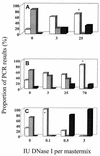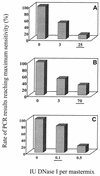DNase pretreatment of master mix reagents improves the validity of universal 16S rRNA gene PCR results
- PMID: 12682181
- PMCID: PMC153871
- DOI: 10.1128/JCM.41.4.1763-1765.2003
DNase pretreatment of master mix reagents improves the validity of universal 16S rRNA gene PCR results
Abstract
DNase I pretreatment of 16S rRNA gene PCR reagents was tested. The DNase I requirement for the elimination of false-positive results varied between 0.1 and 70 IU per master mix depending on the applied Taq polymerase. PCR sensitivity was mostly maintained when 0.1 IU of DNase I was used.
Figures


Similar articles
-
Reagent decontamination to eliminate false-positives in Escherichia coli qPCR.J Microbiol Methods. 2008 Mar;72(3):275-82. doi: 10.1016/j.mimet.2007.12.011. Epub 2007 Dec 31. J Microbiol Methods. 2008. PMID: 18280599
-
Optimization of real-time PCR assay for rapid and sensitive detection of eubacterial 16S ribosomal DNA in platelet concentrates.J Clin Microbiol. 2003 Oct;41(10):4796-8. doi: 10.1128/JCM.41.10.4796-4798.2003. J Clin Microbiol. 2003. PMID: 14532224 Free PMC article.
-
Activity and DNA contamination of commercial polymerase chain reaction reagents for the universal 16S rDNA real-time polymerase chain reaction detection of bacterial pathogens in blood.Diagn Microbiol Infect Dis. 2010 Jan;66(1):41-9. doi: 10.1016/j.diagmicrobio.2008.07.011. Epub 2008 Aug 21. Diagn Microbiol Infect Dis. 2010. PMID: 18722072
-
Contamination and sensitivity issues with a real-time universal 16S rRNA PCR.J Clin Microbiol. 2000 May;38(5):1747-52. doi: 10.1128/JCM.38.5.1747-1752.2000. J Clin Microbiol. 2000. PMID: 10790092 Free PMC article.
-
Effect of comprehensive validation of the template isolation procedure on the reliability of bacteraemia detection by a 16S rRNA gene PCR.Clin Microbiol Infect. 2004 May;10(5):452-8. doi: 10.1111/j.1469-0691.2004.00877.x. Clin Microbiol Infect. 2004. PMID: 15113325
Cited by
-
Optimizing Taq polymerase concentration for improved signal-to-noise in the broad range detection of low abundance bacteria.PLoS One. 2009 Sep 15;4(9):e7010. doi: 10.1371/journal.pone.0007010. PLoS One. 2009. PMID: 19753123 Free PMC article.
-
Prospective study of use of PCR amplification and sequencing of 16S ribosomal DNA from cerebrospinal fluid for diagnosis of bacterial meningitis in a clinical setting.J Clin Microbiol. 2004 Feb;42(2):734-40. doi: 10.1128/JCM.42.2.734-740.2004. J Clin Microbiol. 2004. PMID: 14766845 Free PMC article.
-
Non-culture-based methods to diagnose bloodstream infection: Does it work?Eur J Microbiol Immunol (Bp). 2013 Jun;3(2):97-104. doi: 10.1556/EuJMI.3.2013.2.2. Epub 2013 Jun 5. Eur J Microbiol Immunol (Bp). 2013. PMID: 24265925 Free PMC article.
-
Reagent and laboratory contamination can critically impact sequence-based microbiome analyses.BMC Biol. 2014 Nov 12;12:87. doi: 10.1186/s12915-014-0087-z. BMC Biol. 2014. PMID: 25387460 Free PMC article.
-
A Clinico-Microbiological Study of Prosthetic Joint Infections in an Indian Tertiary Care Hospital: Role of Universal 16S rRNA Gene Polymerase Chain Reaction and Sequencing in Diagnosis.Indian J Orthop. 2019 Sep-Oct;53(5):646-654. doi: 10.4103/ortho.IJOrtho_551_18. Indian J Orthop. 2019. PMID: 31488935 Free PMC article.
References
-
- Altman, D. G. 1991. Comparing groups—categorical data, p. 229-276. In D.G. Altmann (ed.), Practical statistics for medical research. Chapman & Hall, Ltd., London, England.
-
- Böttger, E. C. 1989. Rapid determination of bacterial ribosomal RNA sequences by direct sequencing of enzymatically amplified DNA. FEMS Microbiol. Lett. 65:171-176. - PubMed
-
- Böttger, E. C. 1990. Frequent contamination of Taq polymerase with DNA. Clin. Chem. 36:1258-1259. - PubMed
Publication types
MeSH terms
Substances
LinkOut - more resources
Full Text Sources
Other Literature Sources

